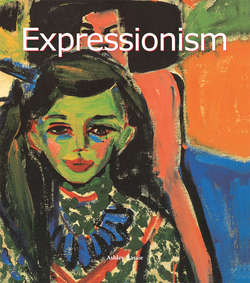Читать книгу Expressionism - Ashley Bassie - Страница 6
На сайте Литреса книга снята с продажи.
THE SELF AND THE PSYCHE
ОглавлениеOskar Kokoschka, Cotton Picker, 1908.
Tempera painting, 94.5 x 39.2 cm.
Kunsthalle, Hamburg.
A potent aspect of Expressionism was the conviction, held by its creators, that their endeavours were carrying art into a wholly new realm of experience. Expressionist art could display spectacular technical innovation, as even relatively early works by Egon Schiele and Oskar Kokoschka make clear. However, formal, surface qualities were a means, not an end. Expressionism aspired to give form to nothing less than a new kind of inward vision. It involved a heightened perception that appeared, to some viewers, to verge on clairvoyance. Expressionists sought an intimate, subjective, and deeply resonant communication between the artist and the viewer. Kokoschka described it as “form-giving to the experience, thus mediator and message from self to fellow human. As in love, two individuals are necessary. Expressionism does not live in an ivory tower, it calls upon a fellow being whom it awakens”. This chapter considers this longed-for mediation between the “self” and the viewer by focusing on the work of some of those Expressionists who probed most deeply the psychic life of themselves and their subjects.
Straining against the moral grip of conventions of thought, speech and behaviour inherited from the nineteenth century, Expressionism was the means by which many artists and writers tried to give free expression to the instinctively, authentically wayward psyche – to break out of the straitjacket, as it were. Sigmund Freud’s research into the unconscious and the processes of repression – whereby painful memories or unacceptable impulses are consigned to the unconscious – only appeared to confirm the existence of a powerful and conflict-ridden “inner life”. In attempting to give expression to repressed aspects of the psyche, Expressionist art, literature, theatre, dance and music therefore tended to emphasise what was unruly, violent, chaotic, ecstatic or even demonic. Eros and Thanatos, sex- and death-drives, were recurrent underlying themes. This kind of excavation of the psyche was especially marked in the radical new art that started to emerge from Austria around 1910. As Vienna’s definitive satirist Karl Kraus, put it, “form is not the dress of thought, but its flesh”.
Arnold Schoenberg was a serious painter as well as a composer. By 1909, he said he felt aware that, in his music, he had broken all ties with the past. He was now following, he claimed, a kind of inner compulsion. This was the year he was rapidly composing works such as his one-act opera, Erwartung (Expectation). It revolves around the inner thoughts and emotions of its only character, an unnamed woman, searching for her lover, who she finds has been murdered. Given the impact of Freud’s work in Vienna on the interpretation of dreams, the “royal way to the unconscious”, as Freud put it, it is telling that Schoenberg suggested that his woman’s interior monologue may be an anxiety dream. The scholar of German literature and music, Henry Lea, has described Erwartung in terms that could equally apply to the raw directness and psychological content of paintings by Kokoschka or Schiele at the same time in Vienna:
Конец ознакомительного фрагмента. Купить книгу
